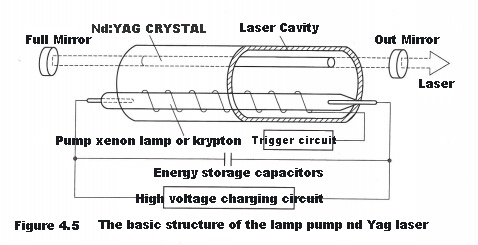What is an Nd:YAG solid-state laser
What is an Nd:YAG solid-state laser
Nd:YAG lasers are sub-solid-state lasers and are currently the most widely used lasers for laser processing besides CO2 lasers. The working medium of the Nd: YAG laser is yttrium aluminum garnet (Y3 A15012) doped with human slave ions (Nd3+) and the activated ion is slave ions. Nd: YAG crystals have very good physical properties, chemical properties, laser properties and thermal properties. Nd: YAG lasers can achieve both pulse output and continuous axial output with an output laser wavelength of 1.06 μm. Metals, especially copper, aluminum and other non-ferrous metals, absorb significantly higher than the 10.65μm laser of CO2 lasers, so it is particularly suitable for the processing of metal materials.

(1) The basic structure of ND YAG lasers. The basic structure of the ordinary lamp pump Nd: YAG laser is shown in Figure 4.5, which is mainly composed of the working substance "Nd: YAG crystal"), the concentrator cavity, the optical resonant cavity, the pump source (hernia lamp or krypton lamp), the power supply system and the cooling system. For the Nd:YAG laser from the Q-tuned object, the cavity is also equipped with a Q switch. The role of the component structure is as follows.
a. Working substances. Solid-state laser working material is the core component of the laser, usually Nd: YAG crystals are processed into cylindrical rods, but also made into strips or discs.
b. Laser cavity. The role of the Laser cavity is to more evenly and efficiently concentrate the pump light on the working substance for higher work efficiency. The Laser cavity is generally made of metal copper or aluminum, the surface is gold-plated or silver-plated, and the single elliptical cavity, double elliptical cavity or multi-elliptical cavity is made according to the number of pump lamps. Oval condensers are often used in lasers with long crystal size, and in order to reduce processing costs and compact structure, they are also made into pattern chambers and tightly wrapped cavities. In recent years, diffuse reflective cavities made of ceramics, PTFE and other materials have also appeared, which are characterized by scratch resistance and high efficiency.
c. Optical resonator. The optical resonator consists of a pair of mirrors mounted parallel on either side of the crystal, one of which is a full mirror and the other is a partial mirror, often referred to as a diaphragm. The parameters of the optical resonator have an important influence on the output characteristics of the laser. The diaphragm of the resonator is made of optical glass or fused silica multilayer dielectric film.
d. Pump source. Nd: YAG laser pump source mainly includes cylinder lamp and krypton lamp, cylinder lamp for lasers with pulse operation, and krypton lamp for lasers working continuously.
e. Power supply system. The power supply system provides electrical energy to the pump source, which converts the electrical energy into light energy through the pump source. For pumping laser working medium
f. Cooling system. The role of the cooling system is to prevent the laser crystal, pump lamp, and condenser from being too hot and is an important part of the Nd:YAG laser. Especially for high-power laser systems, due to the low electro-optical conversion efficiency of Nd:YAG lasers, a large amount of pumped light energy is converted into thermal energy, resulting in a series of problems such as the thermal lens effect of the crystal, which often seriously affects the normal operation of the laser. Therefore, the cooling system is an important guarantee for the stable operation of the laser.





